May 20, 2011
Indirect Solar Forcing of Climate by Galactic Cosmic Rays; Green Energy Failure; Polar Bears Thrive
by Roy W. Spencer, Ph. D.
Evidence that Cosmic Rays Seed Clouds
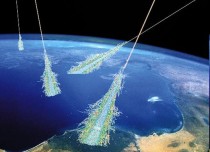
According to a new paper in Geophysical Research Letters, physicists in Denmark and the UK have fired a particle beam into a cloud chamber and shown how cosmic rays could stimulate the formation of water droplets in the Earth’s atmosphere. This is the best experimental evidence yet that the Sun influences climate by altering the intensity of the cosmic-ray flux reaching the Earth’s surface, a hypothesis promoted by Henrik Svensmark.
Roy Spencer, who has been skeptical of Dr. Svensmark’s theory, now accepts that the evidence is becoming too strong for him to ignore. In his blog Dr. Spencer provides supporting graphs and calculations, based on satellite observations, suggesting that direct and indirect (i.e., cosmic ray) solar forcing is 3.5 times that due to changing solar irradiance alone.
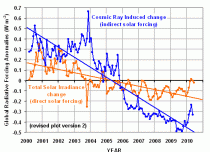
Enlarged.
Read much more here about Roy’s eye-opening analysis that gives credence to Svensmark’s GCR solar effect amplification factor.
--------
Green Energy Failure
By Ross McKitrick, Financial Post
Economist Ross McKitrick applauds the pledge by Ontario PC leader Tim Hudak to roll back key provisions of the Green Energy Act. According to Dr. McKitrick the GEA was proposed as both environmental and job-creation policy, and is a failure on both scores. Any industry that depends on subsidies for its survival is not a net source of jobs.
Countries such as Spain the the UK launched their own versions of the GEA a decade ago, and the resulting job losses have been confirmed by independent analyses (2.2 private sector jobs lost for every green one in Spain and 3.7 for the UK.) Dr. McKitrick points out absurdities in particulate matter calculations for deaths claimed from coal-fired power plants.
Ross concludes:
“If the goal is to reduce air pollution and greenhouse gas emissions, the GEA goes about it in the most costly and ineffective way ever tried -yet another failure. There are cheaper and more effective options that don’t create big cost increases for households and businesses.
Whether the goal is to create jobs or protect the environment, the GEA is a failure, and the provincial Tories should be applauded for taking on the challenge of phasing it out.”
Ross McKitrick is a professor of economics at University of Guelph and senior fellow of the Fraser Institute.
-------
No Decline in Polar Bear Population
Source: CNS

Mother polar bear with cub. (Photo by Scott Schliebe of the U.S. Fish and Wildlife Service)
The Polar Bear Specialist Group of the International Union for the Conservation of Nature (IUCN), the organization of scientists that has attempted to monitor the global polar bear population since the 1960s, has issued a report indicating that there was no change in the overall global polar bear population in the most recent four-year period studied.
“The total number of polar bears is still thought to be between 20,000 and 25,000,” the group said in a press release published together with a report on the proceedings of its 15th meeting. 20,000 to 25,000 polar bears worldwide is exactly the same population estimate the group made following its 14th international meeting. The 15th meeting of the IUCN’s Polar Bear Specialist Group took place from June 29-July 3, 2009 in Copenhagen, Denmark - four years after the 14th meeting, which took place in Seattle, Wash., June 20-24, 2005. But the report on the 15th meeting and its conclusions about the polar bear population - including subsequent information that was developed through March 2010 - was not published until this year (on Feb. 25, 2011).
The group said it viewed anticipated changes in the Arctic environment caused by “climate change” to be the greatest threat to the future of the polar bear.
More likely a threat to continued funding.
In 2008, the U.S. Fish and Wildlife Service declared the polar bear a threatened species under the U.S. Endangered Species Act. The declaration was not based on an actual decline in the polar bear population but on the government’s conclusion that future declines in Arctic sea ice will reduce the bear’s habitat and put it at risk.
May 20, 2011
Another IPCC failure - IPCC’s species extinction hype “fundamentally flawed”
By Anthony Watts, Watts Up With That
Before you read this, I’ll remind WUWT readers of this essay: Where Are The Corpses? Posted on January 4, 2010 by Willis Eschenbach
Which is an excellent primer for understanding the species extinction issue. Willis pointed out that there are a lot of holes in the data collection methods, and that has proven itself this week when this furry little guy (below) announced himself to a couple of volunteer naturalists at a nature reserve in Colombia two weeks ago and was identified as the thought to be extinct red-crested tree rat. It hasn’t been seen in 113 years. Oops.

“extinct” Red-crested tree rat - photo by Lizzie Noble
From the GWPF: IPCC Wrong Again: Species Loss Far Less Severe Than Feared
IPCC report based on “fundamentally flawed” methods that exaggerate the threat of extinction - The pace at which humans are driving animal and plant species toward extinction through habitat destruction is at least twice as slow as previously thought, according to a study released Wednesday.
Earth’s biodiversity continues to dwindle due to deforestation, climate change, over-exploitation and chemical runoff into rivers and oceans, said the study, published in Nature.
“The evidence is in - humans really are causing extreme extinction rates,” said co-author Stephen Hubbell, a professor of ecology and evolutionary biology at the University of California at Los Angeles.
But key measures of species loss in the 2005 UN Millennium Ecosystem Assessment and the 2007 Intergovernmental Panel on Climate Change (IPCC) report are based on “fundamentally flawed” methods that exaggerate the threat of extinction, the researchers said.
The International Union for the Conservation of Nature (IUCN) “Red List” of endangered species - likewise a benchmark for policy makers - is now also subject to review, they said.
“Based on a mathematical proof and empirical data, we show that previous estimates should be divided roughly by 2.5,” Hubbell told journalists by phone.
“This is welcome news in that we have bought a little time for saving species. But it is unwelcome news because we have to redo a whole lot of research that was done incorrectly.”
Up to now, scientists have asserted that species are currently dying out at 100 to 1,000 times the so-called “background rate,” the average pace of extinctions over the history of life on Earth.
UN reports have predicted these rates will accelerate tenfold in the coming centuries.
The new study challenges these estimates. “The method has got to be revised. It is not right,” said Hubbell.
How did science get it wrong for so long?
Because it is difficult to directly measure extinction rates, scientists used an indirect approach called a “species-area relationship.”
This method starts with the number of species found in a given area and then estimates how that number grows as the area expands.
To figure out how many species will remain when the amount of land decreases due to habitat loss, researchers simply reversed the calculations.
But the study, co-authored by Fangliang He of Sun Yat-sen University in Guangzhou, shows that the area required to remove the entire population is always larger - usually much larger - than the area needed to make contact with a species for the first time.
“You can’t just turn it around to calculate how many species should be left when the area is reduced,” said Hubbell.
That, however, is precisely what scientists have done for nearly three decades, giving rise to a glaring discrepancy between what models predicted and what was observed on the ground or in the sea.
Dire forecasts in the early 1980s said that as many as half of species on Earth would disappear by 2000. “Obviously that didn’t happen,” Hubbell said.
But rather than question the methods, scientists developed a concept called “extinction debt” to explain the gap.
Species in decline, according to this logic, are doomed to disappear even if it takes decades or longer for the last individuals to die out.
But extinction debt, it turns out, almost certainly does not exist.
“It is kind of shocking” that no one spotted the error earlier, said Hubbell. “What this shows is that many scientists can be led away from the right answer by thinking about the problem in the wrong way.”
Human encroachment is the main driver of species extinction. Only 20 percent of forests are still in a wild state, and nearly 40 percent of the planet’s ice-free land is now given over to agriculture.
Some three-quarters of all species are thought to live in rain forests, which are disappearing at the rate of about half-a-percent per year.
AFP, 18 May 2011
Species-area relationships always overestimate extinction rates from habitat loss
Fangliang He & Stephen P. Hubbell
Nature473,368-371(19 May 2011)
Extinction from habitat loss is the signature conservation problem of the twenty-first century1. Despite its importance, estimating extinction rates is still highly uncertain because no proven direct methods or reliable data exist for verifying extinctions. The most widely used indirect method is to estimate extinction rates by reversing the species - area accumulation curve, extrapolating backwards to smaller areas to calculate expected species loss. Estimates of extinction rates based on this method are almost always much higher than those actually observed2, 3, 4, 5. This discrepancy gave rise to the concept of an ‘extinction debt’, referring to species ‘committed to extinction’ owing to habitat loss and reduced population size but not yet extinct during a non-equilibrium period6, 7. Here we show that the extinction debt as currently defined is largely a sampling artefact due to an unrecognized difference between the underlying sampling problems when constructing a species–area relationship (SAR) and when extrapolating species extinction from habitat loss. The key mathematical result is that the area required to remove the last individual of a species (extinction) is larger, almost always much larger, than the sample area needed to encounter the first individual of a species, irrespective of species distribution and spatial scale. We illustrate these results with data from a global network of large, mapped forest plots and ranges of passerine bird species in the continental USA; and we show that overestimation can be greater than 160%. Although we conclude that extinctions caused by habitat loss require greater loss of habitat than previously thought, our results must not lead to complacency about extinction due to habitat loss, which is a real and growing threat. See post.
May 19, 2011
Melting icebergs fertilize ocean
By Janet Raloff
Efforts to remove climate-warming carbon dioxide from Earth’s atmosphere appear to be getting a helping hand from a surprising source: the iron in meltwater from Antarctic icebergs.

Icebergs calving off of Antarctica are shedding substantial iron - the equivalent of a growth-boosting vitamin - into waters starved of the mineral, a new set of studies demonstrates. This iron is fertilizing the growth of microscopic plants and algae, transforming the waters adjacent to ice floes into teeming communities of everything from tiny shrimplike krill to fish, birds and sometimes mammals.
To grow, these plants and animals use carbon drawn into the water from carbon dioxide in the atmosphere. Some share of this carbon will eventually be excreted as wastes that fall to the ocean floor, essentially removing it as a near-term climate risk.
“Icebergs should be considered by climate modelers, because the more icebergs that develop [from the breakup of glaciers], the more carbon dioxide you’ll draw out of the atmosphere,” says Ken Smith of the Monterey Bay Aquarium Research Institute in Moss Landing, Calif.
Smith and colleagues first fingered icebergs as hotspots of biological and chemical activity in a 2007 study published in Science. New data from Antarctic cruises in 2008 and 2009 by Smith and other scientists from nine research institutions now appear as 20 papers in the June Deep Sea Research Part II.
Researchers refer to icebergs’ carbon removal as an export. “And the amount of carbon being exported near icebergs is twice as high as in areas away from them,” Smith says.
Counterbalancing icebergs’ carbon removal: No one views the sea-level rise accompanying massive ice melting as a good thing. The rate of iceberg calving - and ice loss - in recent years has increased there, as elsewhere, in response to warming of Earth’s atmosphere.
Prior to the new studies, “we didn’t know the nature of the biological communities associated with icebergs and we certainly didn’t know their direct relationship to carbon exports,” says chemist Timothy Shaw of the University of South Carolina in Columbia, who coauthored several of the new reports.
One surprise: The proliferation of phytoplankton - tiny plants at the base of the marine food chain - that were witnessed in the waters around ice floes “could only account for about half of the increased carbon export we measured,” Shaw says. His team now attributes the other half to changes in the chemistry of iron and carbon use by phytoplankton living next to and under the icebergs.
Benjamin Twining of the Bigelow Laboratory for Ocean Sciences in West Boothbay Harbor, Maine, points to another big surprise: Icebergs’ iron enrichment of southern waters could vary by a factor of 100 from one iceberg to another, or even along walls of a given berg. This patchy enrichment reflects differences in chemical reactions triggered by various organisms and to the unexpectedly complicated turbulence associated with water melting from the floes.
May 17, 2011
Greenland ice in no hurry to raise seas
By Michael Marshall
Good news is rare when it comes to the Greenland ice sheet. Yet a model that accurately mimics the way the ice responds to rising temperatures by slipping and sliding into the sea suggests the resulting rise in sea levels may be smaller than feared.
In its 2007 forecasts of sea-level rise, the Intergovernmental Panel on Climate Change famously excluded contributions from the Greenland and Antarctica ice sheets because the physics were too poorly understood and complex to model. As a result, the IPCC’s estimate that seas could rise by 18 to 59 centimetres by 2100 is almost certainly too low. Indeed, levels are already rising faster than the models predicted.
Using data from the last decade, Stephen Price of the Los Alamos National Laboratory in New Mexico has shown that his modelled ice sheet moves in the same way as the real one does. In particular, the model accurately reproduces how disruptions to the edge of the ice sheet leads to a large initial movement, which is followed by several decades of smaller movement.
Best guess
Price has calculated that changes which the ice sheet experienced between 1997 and 2007 in response to a thermal disruption in the early 2000s will eventually lead to a rise of 0.6 centimetres. Assuming that similar thermal disruptions happen every decade, the moving ice sheet will raise sea levels by about 4.5 centimetres by 2100 (less than 2 inches).
That is about half of a widely quoted previous estimate of 9 centimetres, calculated by Tad Pfeffer at the University of Colorado at Boulder, and colleagues. But Pfeffer’s study was a worst-case scenario, in which all the processes driving sea-level rise were pushed to their absolute limits (Science, DOI: 10.1126/science.1159099).
Pfeffer says Price’s study is a more plausible estimate of what might actually happen. “They use a much more realistic scenario,” he says, “and their model is really grounded in physics.”
Wonderful leap
The model is “a wonderful leap forward,” says Richard Alley of Pennsylvania State University in University Park. But he says the study does not come up with an upper limit on the sea-level rise, as Pfeffer’s worst-case scenario model did.
“In a warming future the [thermal] perturbations might become bigger, or even more frequent,” he says - something that Price’s model doesn’t consider.
Pfeffer counters that, while the pulses of warm seawater disrupting the ice sheet may well become warmer later in the century as global temperatures rise, that doesn’t necessarily mean they will have a bigger effect on the ice. “The response is dictated by what the glaciers are capable of doing,” he explains. “You can yank the plug out harder but it doesn’t make the water run out any faster.”
Journal reference: Proceedings of the National Academy of Sciences, DOI: 10.1073/pnas.101731310
Of course since we are now a decade into a cooling period, expect the melting and sea level rises to be even less.
May 15, 2011
Missing hot spot
By Joseph D’Aleo, CCM, WeatherBell Analytics
In Joe Bastardi’s recent Weatherbell posts he has mentioned the fact that the middle troposphere has cooled in the recent La Nina. This cooling is normal in La Nina. He has alluded to the fact that the tropical high troposphere is supposed to warm the most, as that is the region of greatest greenhouse gas trapping in the models.
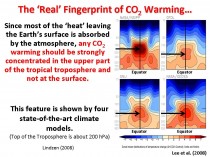
Enlarged.
What does the data show us? The NOAA Angell radiosonde balloon data shows cooling in this critical zone near 200mb in the 20N-20S tropical belt since 1958.
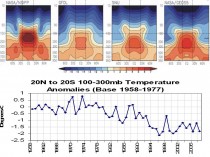
Enlarged.
Some have suggested that the Angell data is an early version and we should use the Hadley upper air compilation. OK this is it. Not as much cooling but no warming in 33 years.
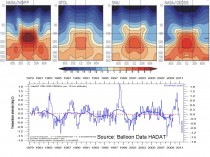
Enlarged.
How about the tropical surface? The oceans in the models are supposed to warm from downward returning radiation supposedly trapped in the atmosphere. The central tropical Pacific ENSO regions are well monitored and the data is reliable and uncontaminated by factors like urbanization. Region NINO34 anomalies are used as the ENSO measure.
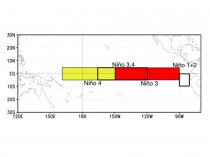
Enlarged.
Here is a plot of the NINO34 temperatures.
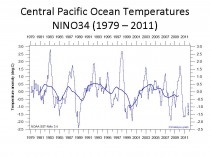
Enlarged.
We see the oscillations up with El Nino and down with La Nina but no real trend since 1979.
Of course that is the ocean surface data. Surely the heat must be trapped (somehow hiding) beneath. Here is a plot of the NOAA average temperatures in the top 300 meters of the entire tropical Pacific from 130E to 80W. Again a spike with the super El Nino in 1997/98 and the compensating dip with the subsequent La Nina in 1998/99 but overall no trend.

Enlarged.
Where is the beef?
|













